Northampton’s Senior Land Use Planner/Permits Manager Carolyn Misch led a workshop on the proposed changes to the Zero Lot Line zoning regulations at Bridge Street School on 3/17/09. The goal of the changes is to facilitate infill by “[simplifying] Zero Lot Line Development to eliminate fences, reduce 30’
side setback to 15’, and allow lots next to non-zero lot projects.”
Here is a complete Google video of the workshop, which is 1 hour and 23 minutes long. This video was recorded by Adam Cohen. It is also available on Vimeo.
Selected highlights:
1:11:16-1:12:03 on video… Former city councilor Alex Ghiselin: “…Particularly as the overriding plan of the city is to create neighborhoods that are walkable, more people living within walkable [distance of] downtown… My question is, you characterized [the URA zoning district] as being suburban, but in fact a bunch of URA is considerably closer to downtown than big chunks of URB and URC…so why not offer this to the URA?”
1:12:44-1:13:40… Misch: “…not all the URA is suburban, but many more of the URB and URC are smaller lots than in the URA, so I think that was probably the first incremental step to try to test the waters to see, you know, is this a provision that makes sense and we also know historically that people tend to feel more comfortable with single-family homes and not for multi-family homes…or two- or three-family structures. Neighborhoods seem to feel more comfortable with new single-family houses… This was also a mechanism to allow some small amount of infill, but with single-family homes as opposed to multi-family. So I think maybe the next step could be to look at URA. I don’t see why not except that…I think the first step was really to look at the more dense neighborhoods.”
1:13:40-1:14:41… Ghiselin: “…Under the general plan of making neighborhoods, increasing walkable places, is the rationale for the project on North Street…Kohl’s project. Significant inroads into greenspace there, at a time when…you have big chunks of the URA where you can’t even have a two-family house. It seems to me that you’re asking, you’re putting…the cart before the horse. You really want to draw concentric rings around areas that you’re looking for density and begin to move in those areas first, so that people in the rest of the city have a feeling of equity…that we’re all…aimed in the same direction.”
1:14:41-1:15:35… Misch: “…To your point…there are some URA neighborhoods right around Jackson Street School that back up to the bike path–very accessible to both Florence and downtown Northampton. I think one of the things that we’ve looked at both from neighborhood interests–or not neighborhoods as a whole, but maybe individual lot owners wanting to…have an extra single-family house that they could carve out from their lot, URA has a bigger lot-size requirement, more depth…so I think a step in that direction would be to actually reduce the lot size requirement in URA… it probably would be worthwhile looking at doing both of those things, lot size just in general but also maybe introducing zero lot line…”
Here are the examples discussed at the workshop and the districts to be affected. This material may also be downloaded as a PDF (983KB).
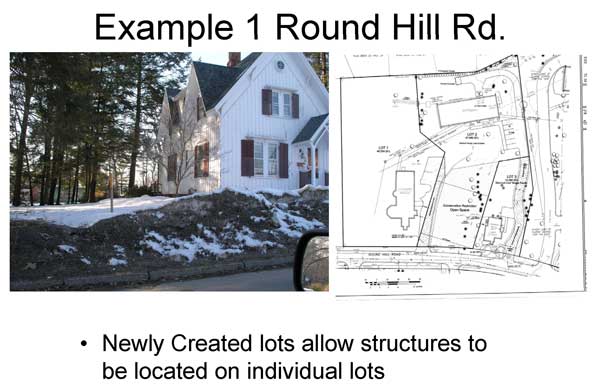
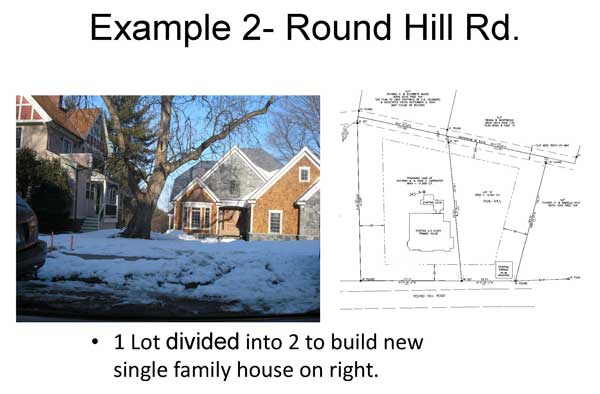
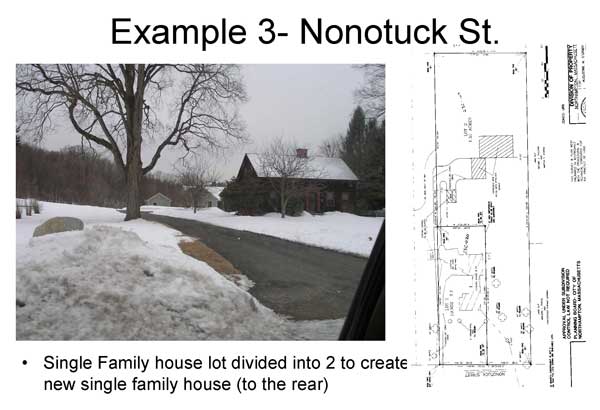
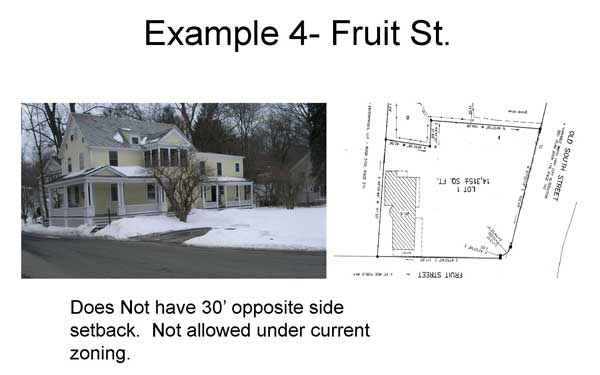
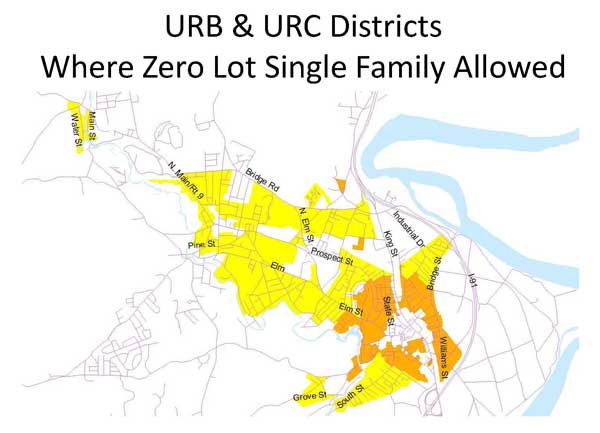
See also:
Gazette: “What’s up with zero lot lines?” (3/2/09)
Such development is allowed in the districts near downtown, as long as the adjoining lots are owned by the same person. New regulations being considered would ease those rules and allow neighbors of adjoining lots to work together.
Video: Planning Board and Ordinance Committee Discuss Zero Lot Line Changes, Traffic Mitigation Payments
[Planning Director Wayne Feiden circulated a handout on the proposed ordinance changes (PDF)]
Some issues that arose during and after the [1/8/09] discussion include:
- Land Use and Conservation Planner Bruce Young favors the adoption of “design standards in architectural ordinances…
Because if we’re saying we want a house between two houses, and we
can’t get the neighborhood to buy onto houses that are just not helping
the neighborhood…” The Planning Board should consider setting aside
infill-related ordinance changes until design standards are in place. Springfield is working on its own infill housing design guidelines as we speak… - If tree canopy is given away piecemeal in our built-up wards and
impervious surface spreads, this could make these wards less pleasant
to live in and more vulnerable to flooding over time. The Planning
Board should track tree canopy and impervious surface by ward and
report it to the public annually. All infill-related ordinance changes
should be evaluated in how they will impact these and other critical
environmental metrics.
More Detail on the Zero Lot Line Proposed Changes; Evaluating Infill Impacts
March 10: Zoning Revisions Committee to Meet; Our Suggestions
The Zoning Revisions Committee is charged with recommending zoning changes that implement the Sustainable Northampton Plan. We urge the committee to keep these considerations in mind:
- Before trying to facilitate infill development, might it be best to first establish infill design standards? (see Springfield)
- How can we encourage development within already paved-over spaces
as opposed to eating into greenspace? Why are spaces in certain in-town
areas like King Street languishing unused? Are there concerns about
hazardous waste that need to be addressed? - How will proposed rule changes affect the quality of life within
in-town districts? Changes that erode amenities (e.g. greenspace),
raise safety issues (e.g. more flooding) or create hassles (e.g. more traffic jams) may defeat the purpose of the Sustainable Northampton Plan by motivating homebuyers to sprawl out elsewhere. - Will the proposed rule changes encourage development that is in harmony with the surrounding neighborhood?
- How will proposed rule changes affect tree canopy ward by ward?
- How will proposed rule changes affect the percentage of impervious surface ward by ward?
- How will proposed rule changes affect the value of neighboring properties?
- How will proposed rule changes affect property taxes? (if you can
build more units on a parcel, its taxable value might increase)
Portland: A Photo Tour of Spiraling Densification
In neighborhoods that are still zoned for single family, Portland has
reduced the minimum lot size. One result is the “skinny house.” This
is not a row house but a 15-foot-wide single-family detached home on
a 25-foot-wide lot. Portland held a competition to design innovative
skinny houses, but in actual practice they all look almost exactly
alike.
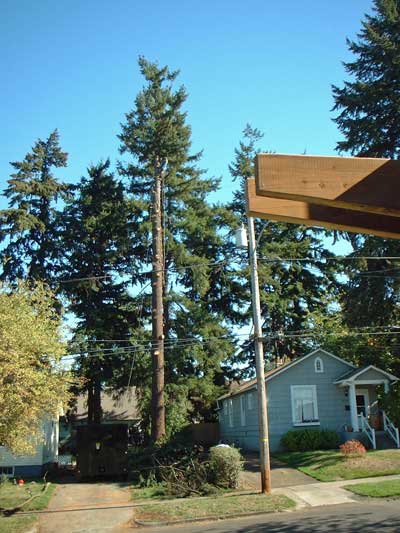
76th before
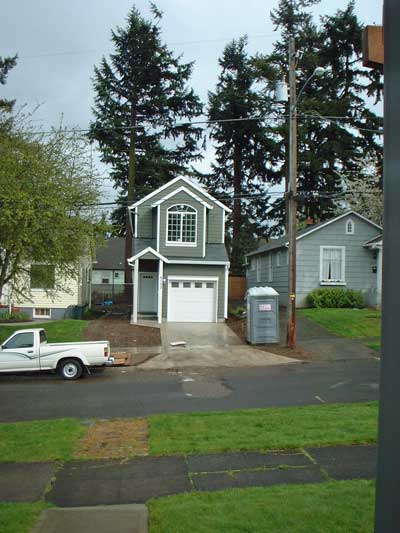
76th after
Video: Conservation Commission Meeting of 3/12/09; Deadlock on Kohl Condo Proposal
3:27:45…: Commissioner Downey Meyer: …While the wetland [on Kohl’s land] is degraded, “this is the wetland that
the people living in this part of the city have. It’s their wetland,
and it may not look as beautiful as a pristine brook out in Mineral
Hills…but it is the wetland that these people have and I don’t think
that I can say because it’s ugly now, because it’s been abused, that
let’s just keep on impacting it.”
Kohl Files Narrative and Drainage Report with Revised Condo Proposal; Interpreting the Wetlands Ordinance
…Attorney Pill leans hard on promotion of infill in justifying his
interpretation of the Wetlands Ordinance. Here is how the Notre Dame
School of Architecture defines “infill” in Envisioning Sustainable Northampton:
“Infill:
noun – new development on land that had been previously developed,
including most greyfield and brownfield sites and cleared land within
urbanized area. verb- to develop such areas.” (page G3)
This definition is not a good fit with most of Kohl’s land off North
Street. This land is largely undeveloped and uncleared, and currently
contains just one single-family house (8 View Avenue). It also contains one of downtown’s few remaining groves of mature trees and buffers a wetland. Responsible–sustainable–infill should not be interpreted as a license to pave over a city’s green infrastructure.
Video: First public “in-process” presentation and feedback session for Design Northampton Week
Fran Volkmann, Vice Chair, Community Preservation Committee
1:09:26-1:10:57
We would like to concentrate development closer in, we like the idea of
walkability, bikeability, neighborhood center… The thing that happens
to us, however, is that we buy that and then somebody builds some
horrible thing…and then they say to you, “This is infill, you know.
It’s good, it’s infill.” …You know if you walk in European cities,
you very often find little tiny pocket parks, and little bits of green
spaces, mixed in with beautiful buildings… How do we…learn
to…value…respect for people at the same time that we try to fill in
our park spaces?